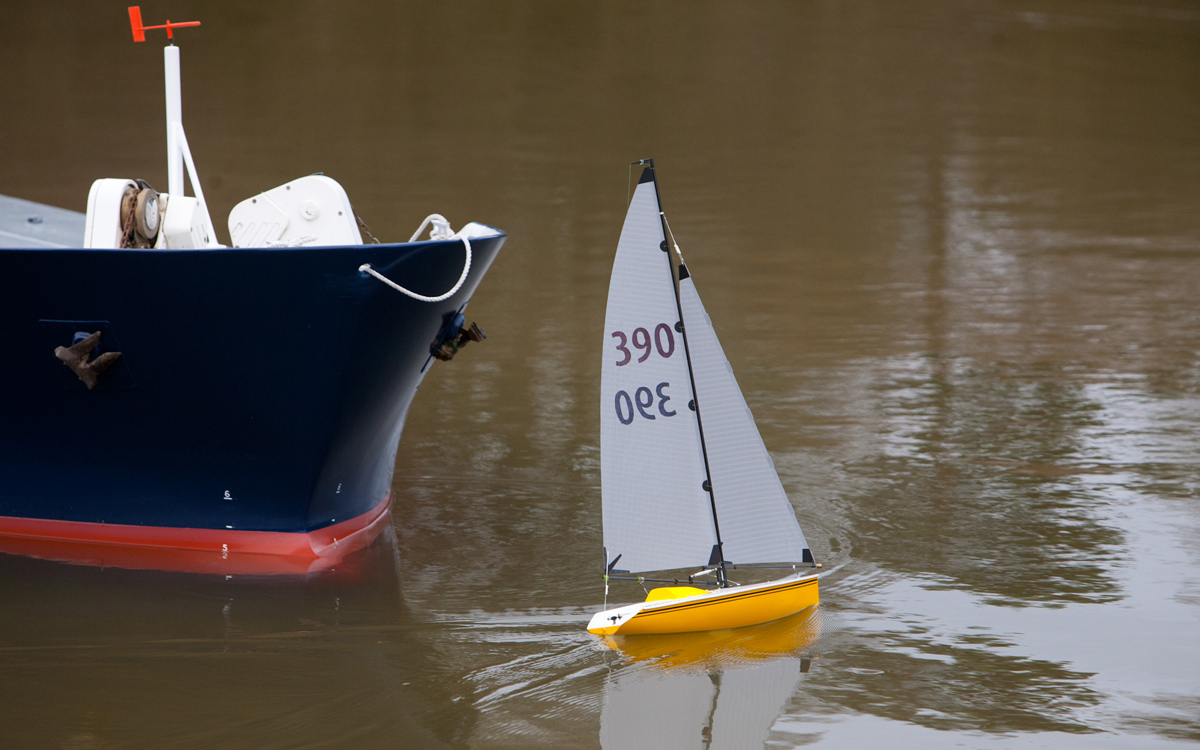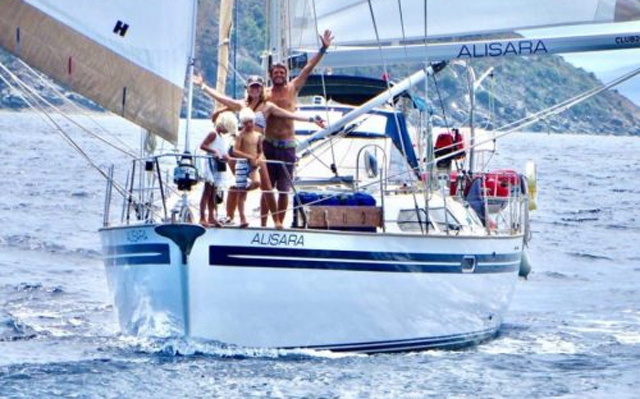Despite being shipwrecked off Portugal, French sailor Yann Quenet is still pursuing his dream of a microyacht circumnavigation. John Jameson reports
Yann Quenet is a genius from Brittany I would love to meet. He is an inventor, designer, and builder of boats, mostly of marine plywood/epoxy, a material I have a great affinity with, having lived through the golden age of the Mirror, GP14 and other similar dinghies. At that time – in the 1970s – the sailing school where I worked in Brittany had 350 plywood keelboats, and dinghies, all designed and built for teaching sailing. I have circumnavigated in a home-built 10m ply/epoxy Wharram catamaran, and lived to write the book, Sea, Sun & Taraipo.

Quenet’s first microcruiser Skrowl took around 200 hours to design and 1,200 hours to build
Yann is an experienced sailor. Currently he is halfway across the Pacific Ocean aboard a cheap and easy-to-build 14ft plywood keelboat named Baluchon. She is his second attempt at producing a minimalist ocean-going keelboat. His first attempt, Skrowl, had a similar-looking chunky, scow-shaped hull with leeboards, which he capsized off Portugal during his first attempt to cross the Atlantic in a 14ft micro-yacht. This is the story of his rescue.
His ill-fated voyage commenced in August 2015 from A Coruña in Northern Spain after he’d towed his boat there from France. When he was 450 miles short of Madeira he was overtaken by a gale, which the boat seemed to handle well, as she ran downwind. However, that night Yann was stretched out on the cabin sole, with the hatch wide open, when he was suddenly woken by a loud crash, and what felt like a bucketful of water on his head. He was catapulted forwards in a deluge of seawater and floating gear. His automatic lifejacket that he wore 24/7, inflated, and he found himself pinned to the new deck-head… the cabin sole! Skrowl had somersaulted in an exceptional wave, filled rapidly, and was now in a stable upside-down position, with Yann in an air pocket inside, gurgling cold seawater.
Disorientated
Disorientated but calm, he felt his way in the darkness for the torch clip, but the torch wasn’t there. Fortunately, a ghostly light drifted by – the tablet/plotter in its waterproof zipped bag. Then he remembered a cheap torch, searched for it, and managed to switch it on. To his surprise it worked.
By torchlight, the scene looked even more eerie, as oars and all the gear that had been carefully stowed, floated to the surface of the air pocket.
Adding to the confusion was the fact that everything on the right was now on the left. Before diving for the EPIRB (and having to remove his lifejacket to do so), Yann had to reverse the left-right image in his mind. Reading the EPIRB instructions with a torch in his mouth was impossible, but he pressed a few buttons and lights started to flash – bingo!
Next, Yann remembered the MOB drill, and tried to release the liferaft that was stowed in the cabin, assuming it had near-neutral buoyancy in the deflated state. No chance! It floated high and pinned itself to the new deck-head.

Built by Yann Quenet, Baluchon is light but strong
However, through perseverance, he wrapped his legs and arms around the raft and forced it down and out into the cockpit, where it trapped itself up against the cockpit sole. He pulled out the ridiculously long painter, and gave it several sharp pulls hoping that the shock of inflation would right the boat. The raft would not inflate. He tied the painter to his lifeline. At that point his legs began to shake, caused by the cold, the adrenaline rush, and the sheer physical effort of trying to escape the nightmare.
Article continues below…
How to understand French VHF méteo weather forecasts
Understanding French VHF weather broadcasts
ColRegs refresher – 12 videos every skipper should watch
Are you windward or leeward? Starboard or port? Do you know Rule 12(iii) and how do you cross a shipping…
Liveaboard diaries – the family sailing around the world in the pandemic
Swimming with turtles January 2020 After leaving St Lucia we’ve been cruising between the Tobago Cays in the Grenadines and…
Survival kit
He then set about hauling the large grab-bag containing enough food and water for several days, into the upside down cockpit, together with the flare container, all of which were attached to his tether.
Now was the moment for Yann to put his head under water and swim out, and up to the surface. Not so fast, the spare clothing canister bumped him and he realised that he’d freeze to death wearing only T-shirt and shorts. Painstakingly he donned a fleece and a pair of pants, then a shoe that floated by, he thought ‘at least I will have one warm foot’.

There’s just about room to lie down in the tiny cabin
The next move was to swim out past the tiller, towing the grab bag and jerry can of water that he fastened to a daggerboard. He had great difficulty in climbing onto the upturned hull, which was as slippery as an ice rink, whilst being pummelled by the waves. With his torch, Yann could see the mast, forehatch, sail, and yard all floating loose. He grabbed the sail and yard – which he jammed into a daggerboard slot to make Skrowl more visible to passing ships – when lo and behold, he saw a ship’s lights, and then another. What luck! He remembered he had a handheld VHF radio in his waterproof grab bag that sadly, had filled with seawater, as had the radio pouch. The radio was dead. He forlornly waved his small torch and saw the first ship disappear behind the waves, but was staggered to see ‘a red and a green’ coming his way. Then a searchlight sweeping from side to side.
It was at this moment he remembered having switched on the EPIRB. He couldn’t believe that such a big vessel would come to his rescue.
Just then a breaker washed him off the hull; thank goodness he was lashed on. He scrambled back onto the upturned hull, but had lost the big torch and Swiss knife that had been tied to his wrist.
The small cargo ship was nearby when men appeared on the lower deck, which was at times awash as the ship lifted and fell several metres with each wave. She sure was an impressive sight, loaded with containers with cars lashed atop.
Grab for safety
Yann was thinking hard about the pending rescue, not knowing how they were planning to get him aboard, and scared of being squashed between Skrowl and the ship. He unclipped his tether from the guardrail, and held onto the clip, ready to snap onto the ship. One of the ship’s crew threw a buoyed line into the water, but there was no way Yann was swimming for that, and ending-up detached between the ship and the upturned Skrowl.
On the top of the next wave, as they drifted together, the ship rolled and he spotted a scupper drain with an iron bar across, which he hung onto for grim death until a crewmember offered a hand.
Yann couldn’t bring himself to let go of the iron bar until he had a foothold on the scupper. His beloved Skrowl rose on the next swell, allowing him to place his dangling foot in the drain and release a hand to be grabbed by the crew.
Goodbye to Skrowl
That was the last he saw of Skrowl. He contemplated a high five with his saviours, but thought better of it as they gave him big smiles, and beckoned him to follow them. The ship was rolling almost as much as Skrowl full of water. He couldn’t bring himself to look back as the ship got under way. Yann was hobbling along with one shoe only, and worried that he might break a toe on a deck fitting, which would be ironic after all that he’d been through. Every 10 seconds or so, the crew turned and gave him a thumbs-up. He could only lower
his head in gratitude. ‘The ship smelled great – of grease and fuel oil!’ he recalled.
After climbing overheated companionways with glaring neon lights, up to the crew quarters, Yann was offered a hot shower, which he nearly turned down, thinking he’d had enough ‘showers’ for one day. They gave him dry clothes, and the captain came to see him and check his passport and ship’s papers.
They gave him some big hamburgers, and he was feeling good. In his mind it felt like the voyage wasn’t over. He felt as elated as when Skrowl was surfing down the waves just a few hours earlier.
He feared the anticlimax when he landed, but in his mind he was already drafting plans for his next boat, Baluchon.
Back to the drawing board

Baluchon was built in a barn
Back to the drawing board in St Brieuc, Yann was determined to design and build a r4,000 microyacht that would self-right and be capable of circumnavigating. In April 2020 he trailed Baluchon overland to Lisbon and from there set off for the Canaries, Guadeloupe, Panama, and Hiva Oa.
The next stop was Tahiti, after carefully threading his way through the virtually invisible, low-lying Tuamotu atolls, using his phone as a plotter. After a hero’s welcome in the capital, Papeete, some fundraising, partying, not much rest, he sailed on to Raietea island, to do final preparations for the long haul to New Caledonia. Surprisingly he did this 2,500 mile leg non-stop in 32 days averaging a remarkable 3.25 knots.
Now in Noumea, he is pondering the next leg having bought a handheld water maker ready for the long-haul.
You can follow Baluchon’s progress on Yann’s website, boat-et-koad.com. The site is in French and is full of excellent photos and videos of the design, build, and testing process.
About the author
John Jameson has been sailing for 64 years. He managed the Glenans Sailing School in Brittany, and was the RYAS National Sailing Coach. His new illustrated book Sea, Sun & Taraipo describes nine years of colourful adventures while circumnavigating slowly, and is available from Amazon and Bookshop.org
Why not subscribe today?
This feature appeared in Practical Boat Owner magazine. For more articles like this, including DIY, money-saving advice, great boat projects, expert tips and ways to improve your boat’s performance, take out a subscription to Britain’s best-selling boating magazine.
Subscribe, or make a gift for someone else, and you’ll always save at least 30% compared to newsstand prices.
See the latest PBO subscription deals on magazinesdirect.com







